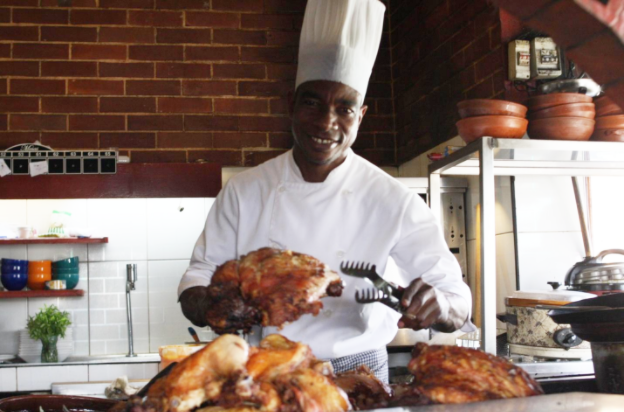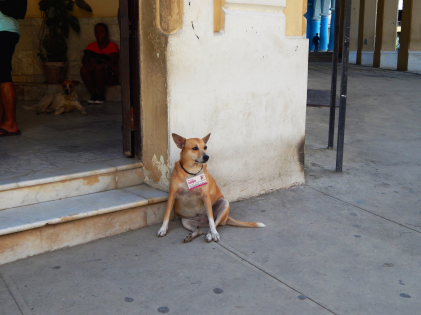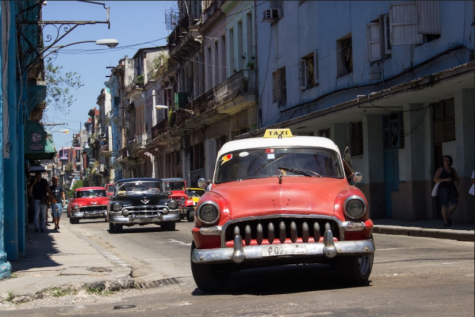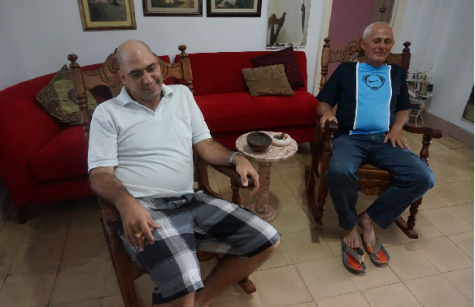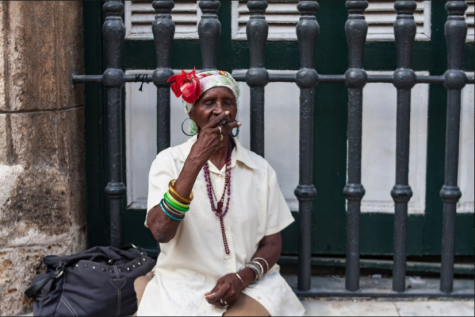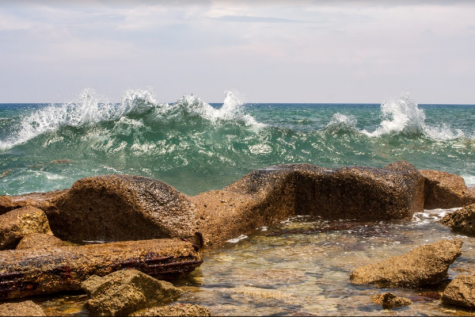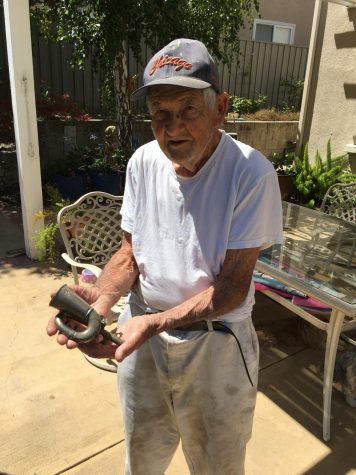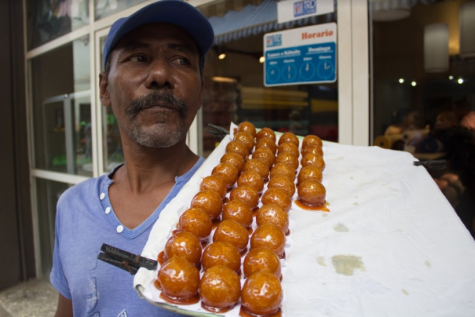Cuban restaurants find ways to thrive despite US embargo
August 28, 2017
Shortly after 12 p.m. on a Thursday in Old Havana, a man donned in chef’s outfit is yelling out to people as they pass by in the sweltering sun. The chef is wearing a white hat and a short-sleeve shirt, black pants and shoes, and a scowl that would make Scrooge appear friendly.
He is speaking in English and in Spanish as he tries to rally customers to stop at his restaurant: “Hungry? Agua? Limonada? Come!” Most people walk by, avoiding eye contact, or look at him with bewilderment.
The outdoor restaurant is virtually empty except for a group of American tourists who have stopped for water and a break from the afternoon sun. The two waitresses on shift are trying to find ways to stay busy. One waitress is behind the bar resting her head on her hand and the other waitress is pacing back and forth while swinging her arms. The small view of the kitchen is lifeless and undisturbed. There is no food is in the window waiting to be delivered to hungry patrons. Walking through parts of Old Havana, this scene was far too common. Some restaurants were virtually empty while others were thriving and so full of life.
What made the difference?
Somewhere around 80% of Cuba’s industries are owned and operated by the Cuban government, including restaurants. It has been this way since 1960’s when Cuba became a socialist government. Under the socialist regime, the Cuban government made a leveled economic playing field for its citizens, essentially squelching any capitalistic aspirations. However, in 2011, the government relaxed regulations allowing more private citizens the opportunity to own and operate their own businesses. Private restaurants, also known as “paladares,” have increased in double digits, providing locals and tourists alternative eating options to state-ran restaurants. According to Isabel Ferrás, owner of Razones, “the food in private restaurants are more flavorful and the service is better. State-ran restaurants are not as nice.” Despite being cut-off from international trade with the United States, Cuba is still able to create some very popular eateries that serve some amazing dishes.
Razones is a paladar that has been in operation since 2011. The restaurant serves Cuban-Caribbean inspired dishes for prices equivalent to 2 to 15 USD. The paladar is located on the second floor of an old mansion. As you walk up the stairs to head to the dining room, the stairwell is filled with photographs of their most favorite and frequent customers. When Razones opened, the restaurant was very small, serving about 20 customers at one time. In 2014, the restaurant expanded and added more dinning space and a second kitchen. The new addition can accommodate another 20 to 24 customers. The additional space was much needed as Razones serves an average of 600 customers a day.
The restaurant owner, Isabel Ferrás, dreamed of owning her own restaurant when she was a young girl. Ferrás was born in Cuba but spent some of her childhood growing up in North Korea and India. During her adolescence, her parents moved back to Cuba where she graduated high school and went on to attend the University of Havana. She earned a degree in accounting and worked in accounting for 9 years as a government administrator. After her government job, she went to work at a restaurant in Chinatown. Ferrás said that she learned a lot about the restaurant business from working in Chinatown. She continued to work in Chinatown for 17 years before she left to start her own restaurant. With Ferrás’s quiet demeanor and magnetic personality, she brought a lot of the employees who she worked with in Chinatown to work with her at Razones.
Ferrás said it was important for her to open her own restaurant because she wanted to serve her community. However, she says that her main business challenge is being able to partner with quality businesses to supply her restaurant, “the government makes it difficult for small business owners.” She went on to explain that the Cuban government makes it difficult for small businesses to operate because they require a license for every product category that they sell. She said that there is room for both socialism and capitalism. To prove her point, she gave an analogy of a pyramid. Ferrás believes that the Cuban government can focus on the top of the pyramid – generating money from government businesses while still providing free education and healthcare, and making it easier for entrepreneurs to focus on the bottom half of the pyramid. Hence making it easier for small businesses to work and supply for each other. She said that she hopes that the Cuban government moves to a freer enterprise after Raul Castro steps down in 2018. Another paladar that is also challenged with finding quality vendors to source their restaurant is El del Frente.
El del Frente is a trendy private restaurant located in busy Old Havana. It is the second of two businesses to be opened by the same owners. The first business, directly across the street, is a bar called O’Reilly 304. After the popularity of O’Reilly’s, the owners and brothers, Jose Carlo and Julio Cesar Imperatori opened El del Frente in November 2015. El del Frente is located on the 2nd and 3rd floor of an old converted building. O’Reilly’s and El del Frente serve similar food but El del Frente is more spacious and has the added space of the 3rd-floor rooftop terrace. On Friday nights, restaurant goers can enjoy cocktails while listening to live jazz on the rooftop terrace. Chef Roberto Garriga delivers a fusion of Latin and Cuban food. On the menu, customers will find items like seafood spaghetti and my favorite, the tacos. The meal prices range from the equivalent of 8 to 14 USD. This place is definitely a hot-spot for tourists. According to shift-manager, Alejandro, El del Frente serves over 1,000 customers per day. He said that in addition to attracting tourists, celebrities like Will Smith and Usher have also dined at their restaurant.
All the meat and produce served at El del Frente are natural and organic. Alejandro says that each day, staff goes to the local market to purchase ingredients needed for that day. Unfortunately, sourcing for the restaurant can be difficult. Since the restaurant does not have a supplier that can consistently supply the restaurant, they must purchase their ingredients from state-ran markets. Alejandro says that when they face issues with ingredient shortages, they either substitute other ingredients in a dish or they do not provide that menu item to their customers. Alternatively, some owners have been able to successfully source for their restaurants. One such restaurant that has successfully overcome issues with food sourcing is Mediterraneo Havana.
Located in a converted mansion, Mediterraneo Havana is a paladar that has been in business since 2013. With an ambiance reminiscent of a blue and white, coastal beach home, Mediterraneo offers meals that are a combination of Cuban and Mediterranean-Italian cuisine. The food is a direct reflection of the roots of the Cuban owner, Raul Relova, and the Sardinian chef, Luigi Fiori. Mediterraneo boast of a multi-course menu and fresh farm-to-table menu items. Since Cuba is cut-off from oil, fertilizers, and pesticides, there is a heavy reliance on organic farming. Relova leads many local projects that support sustainable agriculture to help supply natural ingredients to restaurants. In order for Mediterraneo to provide fresh ingredients to their customers, they partner exclusively with two farms located in Guanabacoa, a rural township in eastern Havana. Mediterraneo uses these farms to source their produce, eggs, and poultry. The restaurant also owns its own fishing boat that provides all of the restaurant’s seafood items. When sampling Mediterraneo’s menu, one can definitely taste the freshness of the dishes. One dish that must be ordered while visiting is the lobster spaghetti. The average price for a meal ranges from the equivalent of 4 to 18 USD. During the restaurant’s short tenure, it has been recognized for many awards during the four years it has been in operation. Most notably, they have been recognized for the 2016 Trip Advisor Certificate of Excellence; the 2015 International Quality Crown Award, London; and a 2016 Latin America Quality Award.
Not only does Mediterraneo offer some of Havana’s best dishes, but they are also on the cutting edge of technology. The wait staff will take your order on a tablet, which is automatically sent to the kitchen. They have also begun offering Wi-Fi to customers who dine at their restaurant. Another Havana restaurant that has been able to source their restaurant and thrive is El Idilio.
El Idilio is an outdoor restaurant that caters to the culinary experience. The restaurant has the feeling of an American barbeque equipped with a huge grill and red-checkered tablecloths. The menu, however, is far more sophisticated than an American backyard barbeque. An open view of the outdoor kitchen allows restaurant goers to watch the chefs as they work. The kitchen is definitely part of the dining experience as most two-person tables face the chef. The restaurant opened in 2012 and offers everything from Cuban classics such as ropa vieja to items like shrimp tacos. The average price of meals ranges between the equivalent of 6 to 11 USD.
Similar to Mediterraneo, El Idilio has found a way to work with local farmers to supply produce to their restaurant but no one was willing to elaborate on how. Generally speaking, it is not uncommon for chefs to bring spices or supplies back from other countries while they are vacationing. For instance, during the time of my interview, Chef Luigi Fiori at Mediterraneo left for a vacation to Italy. While no one at Mediterraneo commented on this, it is possible that Chef Fiori will bring back items from Italy in his personal luggage that will supply his restaurant. I could definitely taste some amazing olive oil in the lobster spaghetti. Nonetheless, employees seem to be very dedicated to their jobs at the “paladares” and take great pride in delivering quality products. Quality is a trait that seems to be pretty consistent amongst the private restaurants that I visited.
Cubans earn an average of 30 CUC per month, which is equivalent to 30 USD. Most employees work an average of 12 hours a day, and sometimes longer. A bartender at Razones, Ernesto, told me that sometimes he works 16 hours per day. He says that he comes in early to help prepare for opening and stays late to help clean up after a busy night. The number of workdays per week seems to depend on the position of the employee and the total number of employees working at a restaurant. Some of the people that I spoke to work every other day while others only take one day a week off. All of these private restaurants charge customers a 10% service fee that is used to pay the staff. Cuba is not a tipping culture, but any tip earned goes directly to the wait staff.
As far as taxes are concerned, the owners of the “paladares” are required to pay the Cuban government 10% of their restaurant’s earnings. Any earnings that are beyond the 10% tax rate is considered profit for the restaurant.
While President Obama began restoring relations with the Cuban government, no one knows what the future holds under President Trump and the fact that Raul Castro is retiring in 2018. 2018 will be a year of uncertainty for Cuba. For the first time in over 40 years, a non-Castro will lead the country into the future. Razones’ owner, Isabel Ferrás, may get her wish of a freer Cuban enterprise. However, despite the United States embargo, Cuban restaurants have still found creative ways to serve their customers and create great food. No matter if “paladares” are purchasing from state-ran grocery stores or partnering with organic farmers, something tells me that they will find success. As Ferrás put it, “Cubans are resilient. We have a sense of pride and solidarity and we want to see other Cubans succeed no matter what.”




